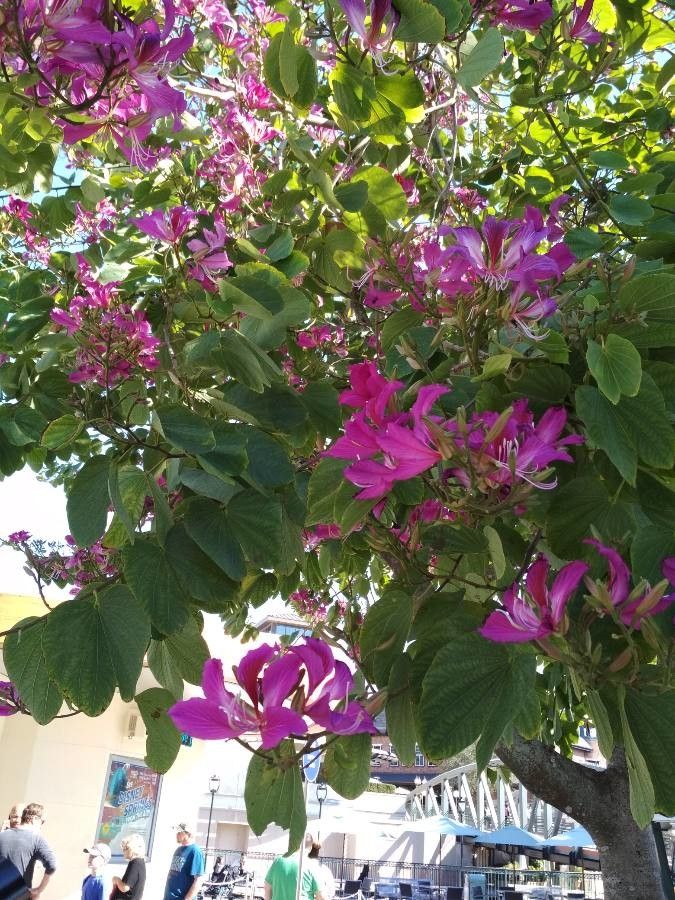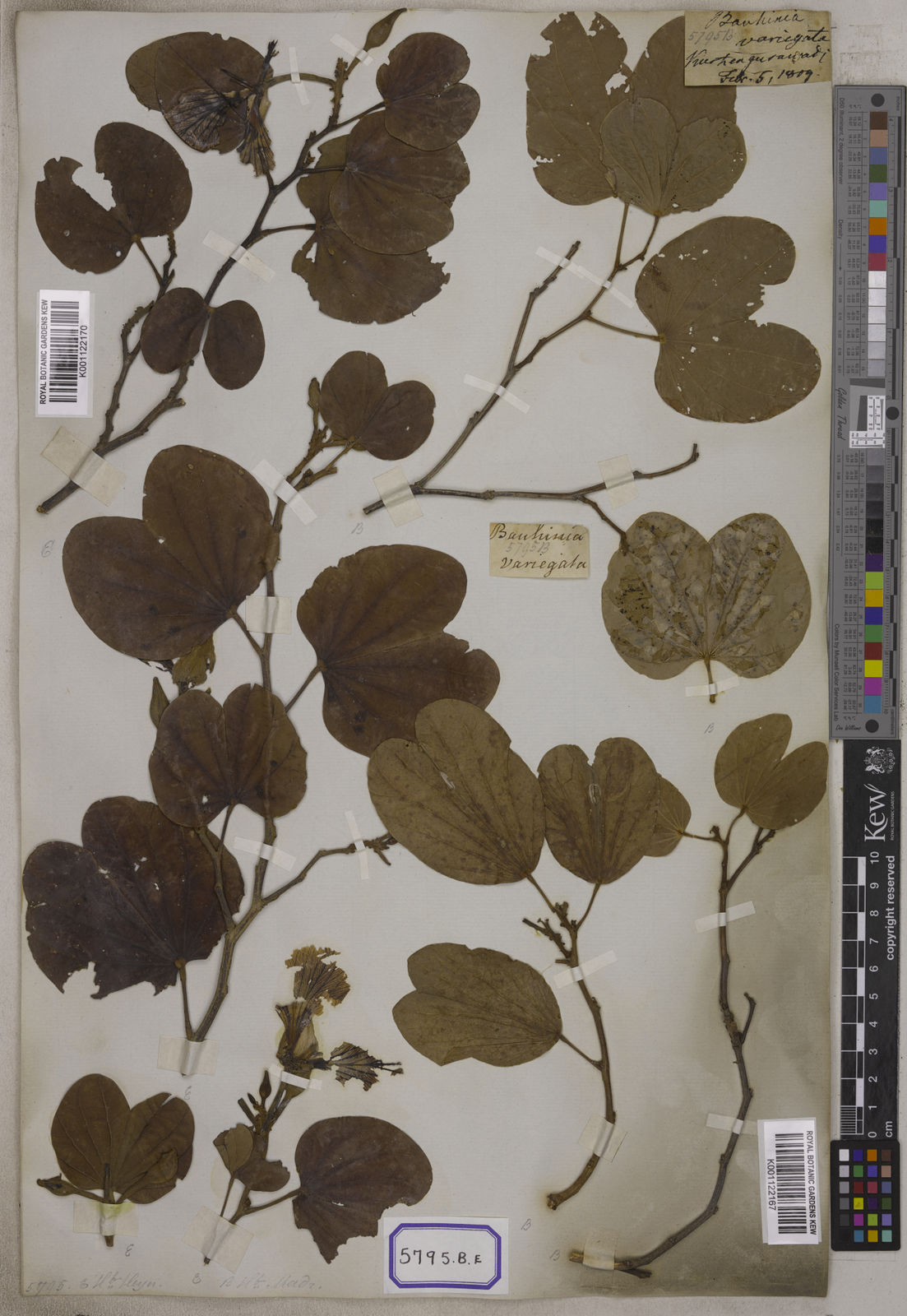Caterpillar Tree, Orchid Tree, Camel's Foot Tree
bauhinia variegata
Also known as: ["Orchid Tree","Camel's Foot Tree","Mountain-ebony"]
Overview
A deciduous tree known for its strikingly beautiful, orchid-like flowers with variegated colors, typically pink, purple, or white.
Benefits & Perks
["long-flowering","fragrant flowers","wildlife attractant (bees, butterflies, birds)"]
Botanical Classification
| Phylum: | Magnoliophyta |
| Class: | Magnoliopsida |
| Order: | Fabales |
| Family: | Fabaceae |
| Genus: | Bauhinia |
| Botanical Name: | Bauhinia variegata |
Plant Characteristics
Basic Information
- Category: Trees
- Suitable Location: outdoor garden in temperate to tropical regions, or as a container plant in cooler climates
- Suitable For:
- Is Weed: No
- Allergenicity: low
Environmental Needs
- Climate: {"temperatureRange":"10–35°C"}
- Hardiness: {"zones":"9–11"}
- Misting: rarely required unless in very dry indoor conditions
- Drainage: Fast-draining to prevent waterlogging.
- Soil Type: Well-draining, loamy soil with added organic matter; can tolerate slightly sandy conditions.
Maintenance Level
- Maintenance Level: moderate
- Toughness Level: moderate
- Pruning Frequency: Annually in late winter or early spring before new growth begins.
- Pruning Intensity: Moderate; remove up to one-third of old growth to rejuvenate the plant.
Care Details
Ideal Sunlight Coverage:
Full sun to partial shade; 6–8 hours of direct sunlight daily, with some afternoon shade in hot climates.
Sunlight Tolerance Tips:
Acclimate new plants to sunlight gradually; protect from intense midday sun to prevent scorching; adjust placement based on indoor/outdoor conditions.
Care Requirements
Care Difficulty
moderatemoderate
Sunlight
full sun to partial shade
Rotate plant for even light exposure; use sheer curtains to filter intense sun; monitor for leaf burn.
Watering
every 7–10 days during active growth, reduce in winter
Water thoroughly until it drains from the bottom; allow soil to dry between waterings; avoid overwatering.
Soil
well-draining, loamy soil with organic matter
pH: Slightly acidic to neutral, pH 6.0–7.0.
Use a mix of potting soil, perlite, and compost; avoid heavy clay soils; check drainage before planting.
Temperature
Prefers warm temperatures, 65–85°F (18–29°C); tolerates mild frosts but thrives in tropical to subtropical climates.
Protect from frost; ensure good air circulation; adjust watering for temperature changes.
Fertilizing
every 4–6 weeks during growing season with balanced liquid fertilizer
Apply fertilizer after watering to prevent root burn; avoid fertilizing newly repotted plants for 4–6 weeks.
Propagation
Methods
Stem cuttings or seed; stem cuttings are more common for home growers.
Step-by-Step Propagation Guide
- Take a 4–6 inch cutting.
- Remove lower leaves.
- Apply rooting hormone.
- Plant in medium.
- Keep moist and warm.
Best Time: Spring or early summer when the plant is actively growing.
Environment
Warm, humid environment with indirect light; maintain temperatures around 70–75°F (21–24°C).
Medium
Well-draining mix of perlite and peat moss or cactus mix.
Hormone
Rooting hormone is recommended to improve success rates.
Timeline
Roots may develop in 4–8 weeks; new growth in 2–3 months.
Tools Needed
Pruning shears, rooting hormone, small pots, well-draining medium.
Quick Tips
Use healthy, non-flowering stems; maintain high humidity with a plastic cover; avoid direct sunlight.
Pruning & Repotting
Pruning Guide
Method
Selective pruning to maintain shape; cut just above a leaf node or bud.
Pruning Plan
Shape the plant, encourage bushier growth, and remove dead or diseased branches.
Tools
Pruning shears, loppers (for larger branches), sterilizing solution.
Checklist
Sterilize tools; prune dead/diseased wood first; make clean cuts; dispose of clippings.
Repotting Guide
Best Season
Early spring before active growth starts.
Pot Size
Increase pot size by 2–3 inches in diameter; ensure good drainage holes.
Method
Remove plant gently; trim roots if needed; place in new pot with fresh soil; water lightly.
Suggestions
Repot every 2–3 years or when roots fill the pot; necessary to refresh soil and provide space.
Checklist
Choose appropriate pot; prepare new soil mix; handle roots carefully; water after repotting.
Advanced Care Tips
Watering Mastery
Watering Checklist
Check soil moisture; water deeply; ensure drainage; adjust for season.
How to Apply Water Properly
Water at the base of the plant, ensuring moisture reaches the root zone; water early in the morning to minimize evaporation; ensure excess water drains away to prevent waterlogging.
Watering Schedule Tips
Water deeply once the top inch of soil is dry; reduce frequency in winter to prevent root rot.
Soil Improvement
Add perlite or sand for drainage; incorporate compost for fertility; ensure good aeration.
Temperature Stress Management
Signs of Temperature Issues
Leaf drop, yellowing, or wilting in cold; scorching or stunted growth in excessive heat.
Cold Stress
Slows growth, may cause leaf drop or dieback; vulnerable to frost damage below 28°F (-2°C).
Solution: Move to a sheltered location; provide frost protection; avoid overwatering in cold conditions.
Hot Stress
Wilting, leaf scorch, or reduced flowering due to excessive heat and dryness.
Solution: Provide shade during peak heat; increase humidity; water more frequently but avoid waterlogging.
Fertilizing Guide
Fertilizing Checklist
Check fertilizer type; dilute correctly; apply during active growth; avoid contact with roots.
Fertilizing Method
Use balanced liquid fertilizer diluted to half strength every 4–6 weeks during growing season (spring/summer); reduce or stop in fall/winter.
Common Problems & Solutions
Toxicity Warning
Cats
Slightly ToxicCats may experience mild gastrointestinal irritation if they ingest Bauhinia variegata seeds or pods. The toxic compounds can cause digestive upset, though severe reactions are rare.
⚠️ Symptoms:
🌿 Toxic Parts:
⚡ Toxic If:
if eaten
Dogs
Slightly ToxicIn dogs, ingestion of Bauhinia variegata seeds and pods can lead to mild gastrointestinal upset due to the presence of lectins and other irritants. The effects are generally not life-threatening but can cause discomfort.
⚠️ Symptoms:
🌿 Toxic Parts:
⚡ Toxic If:
if eaten
Humans
Slightly ToxicBauhinia variegata contains compounds that can cause mild gastrointestinal distress when ingested. The seeds and pods are the primary toxic parts, containing lectins and other bioactive compounds that may disrupt digestive processes.
⚠️ Symptoms:
🌿 Toxic Parts:
⚡ Toxic If:
if eaten
Frequently Asked Questions
Q: How tall does Bauhinia variegata grow?
A: It typically reaches 10–15 meters in height, though it can grow taller in optimal conditions.
Q: Does it require full sun?
A: Yes, it thrives in full sun but can tolerate partial shade.
Q: Is it suitable for cold climates?
A: It prefers warm climates and may not survive in regions with severe frost.
Quick Reference
| Family: | Fabaceae |
| Care: | moderate |
| Light: | full sun to partial shade |
| Water: | every 7–10 days during activ |
Get Expert Care Tips
Download the Plantious app for personalized care reminders and plant identification!
Google Play App Store








